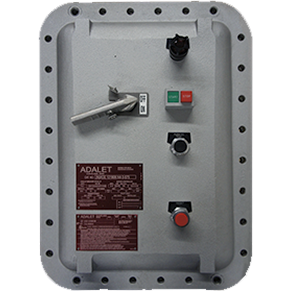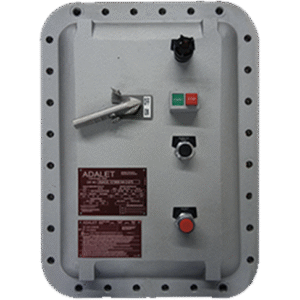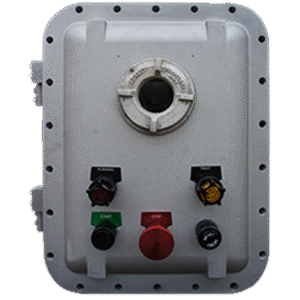Flameproof and explosion proof enclosures have subtle differences and maybe following the different standards, which are used for ensuring equipment and enclosures safety in Europe and North America.

The terms flameproof and explosion proof have one and the same meaning, in that the enclosures are constructed to have features through which the internal ignition within an enclosure is not transferred or transmitted to the outside. Therefore these enclosures safeguard the operational exteriors, which may have the flammable substances that can be a cause of fire and/or explosion.
What Is an Explosion-Proof Enclosure?
The ANSI/UL 1203 standard is used in North America and details the requirements relating to the dust/ignition proof and explosion proof enclosure and electrical equipment that are installed in a hazardous environment. It also includes the requirements for equipment to be used in Class 1 & 2, Group A, B, C and D, and the Division 1 scenarios.
An explosion-proof enclosure is a protective housing designed to contain any sparks, flames, or explosions that may occur within electrical components, preventing ignition of surrounding hazardous gases or vapors. Commonly used in industrial settings like oil and gas or chemical plants, these enclosures are built to rigorous standards (such as NEC or ATEX) to ensure safety in classified hazardous areas.
What Is a Flameproof Enclosure?
The IEC 60079-1 standard is specific to Europe and is also supported by the IEC 60079-0 standard of general requirements relating to the electrical apparatus. The standard provides the specific regulations for electrical equipment that are to be used in the explosive and hazardous gas environment.
A flameproof enclosure is a type of protective housing designed to withstand an internal explosion and prevent the transmission of flames to the surrounding atmosphere. Commonly used in hazardous areas with flammable gases or vapors, it contains potential ignition sources within and ensures any explosion is safely vented without igniting external environments. Flameproof enclosures are typically certified under standards like ATEX or IECEx.
Key Differences Between Explosion-Proof and Flameproof Enclosures
Below are the underlying differences between the European and North American standards.
1. General Differences
IEC 60079-1 is specific to gas and vapour, while ANSI/UL 60079-1 covers dust and gas. Different vapours and gasses are also grouped differently under the various divisions and classes in the standard ANSI/UL 60079. On the other hand, the ICC 60079-1 groups the gases together in its Group to 2C.
2. Constructional Differences
The North American ANSI/UL1203 standard specifically points out towards the weather-proofing and ingress requirements for the electrical enclosure that is to be placed outdoors. This IP rating is not present in the IEC 60079-1 standard. The IEC standards also do not have the wall thickness or gasket requirements for the enclosure while the same is present in the ANSI/UL standard. The ANSI/UL standards are also more explicit regarding the conduit cabling systems, plugs, valves, fittings and rust protection. The North American standard has a more stringent requirement for the non-metallic enclosures while requiring certain extra performance tests as well.
Also Read: Get High Quality Explosion Proof Motor Control Panels in Canada
Difference #1: Specification protocol
The primary difference in specification protocol lies in regional standards. Explosion-proof enclosures follow North American standards such as NEC and UL, while flameproof enclosures adhere to international standards like IEC and ATEX. This affects design, testing, and certification requirements. For example, UL standards focus on containment, whereas ATEX emphasizes preventing flame propagation through tested flame paths.
Difference #2: Testing parameters
Explosion-proof and flameproof enclosures undergo different testing protocols. Explosion-proof enclosures are tested to ensure they can contain internal explosions without igniting external gases, often using pressure and impact tests per UL or CSA standards. Flameproof enclosures, tested under ATEX or IECEx, focus on verifying that internal flames are cooled and prevented from escaping through flame paths, ensuring safe operation in explosive atmospheres.
Difference #3: Markings
Markings on explosion-proof and flameproof enclosures differ based on regulatory standards. Explosion-proof enclosures, following NEC or UL standards, are marked with class, division, and group designations (e.g., Class I, Div 1, Group B). Flameproof enclosures under ATEX or IECEx include zone classifications and specific alphanumeric codes indicating protection type (e.g., Ex d IIB T4), helping users identify suitability for hazardous environments.
Difference #4: Protection covers
Protection covers differ in design and function between explosion-proof and flameproof enclosures. Explosion-proof enclosures often feature heavy-duty, threaded or bolted covers designed to withstand internal blasts. Flameproof enclosures use precision-machined flame paths at joints or covers to cool escaping gases and prevent ignition outside the enclosure. Both types ensure containment but employ different methods suited to their respective certification standards.
Which Standard Should Be Your Choice
IEC 60079-1 is a widely accepted and internationally recognised standard for all kinds of flameproof enclosures. But one cannot ignore the size and depth of North American market and therefore following of the ANSI/UL 1203 standard also becomes necessary. North America has also drifted towards the adopted version of the standard IEC 60079-1, the ANSI/ISA 60079-1 Standard, which also has many deviations as well. As the differences narrow down, the future is bright and welcoming for the manufacturers.
The leading manufacturers can help you find the right hazardous location panel and enclosure that complies with the standards of the respective markets. They carry out the extensive confirmatory and assessment works to ensure that the panels befit the given hazardous environment and can protect your processes from any kind of danger and mishap. The best of suppliers are also operating online and provide to you the world-class electrical enclosures and panels with all the features you desire, at an affordable and marginal cost.
Choosing the Right Enclosure for Your Needs
Choosing the right enclosure depends on the hazardous environment, applicable standards, and regional regulations. For North America, explosion-proof enclosures certified by UL or CSA are typically required. In international or European settings, flameproof enclosures meeting ATEX or IECEx standards are preferred. Consider factors like gas group, temperature rating, and zone or division classification to ensure safety and compliance with local codes.
Why Compliance Matters
Compliance ensures safety, legal adherence, and operational reliability in hazardous environments. Using certified explosion-proof or flameproof enclosures protects workers, equipment, and facilities from catastrophic incidents. Non-compliance can lead to fines, shutdowns, or accidents. Adhering to standards like NEC, UL, ATEX, or IECEx demonstrates due diligence, boosts credibility, and ensures your equipment meets industry-specific safety and performance requirements.
Conclusion
Understanding the differences between explosion-proof and flameproof enclosures is essential for selecting the right protection in hazardous environments. Each type follows specific standards and serves the same critical purpose—preventing ignition of flammable gases or vapors. By choosing the correct enclosure and ensuring compliance, you enhance safety, meet regulatory requirements, and protect both personnel and equipment in high-risk industrial settings.


